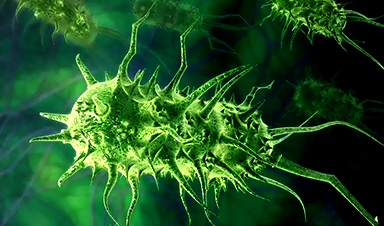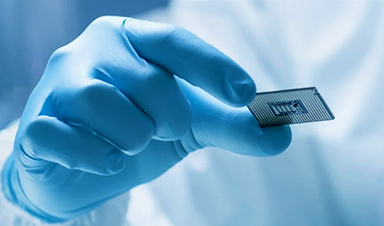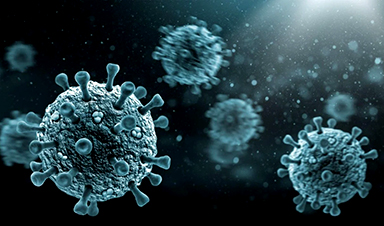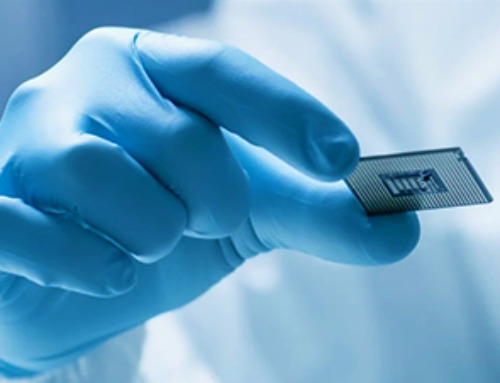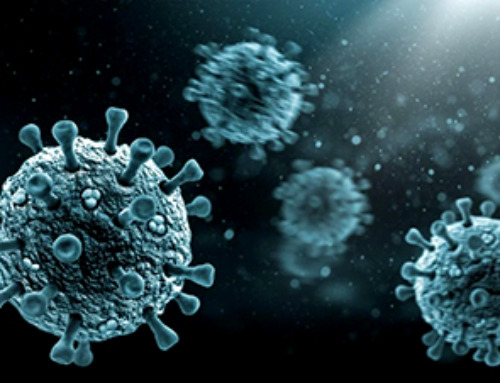Decades of work by a series of researchers has led to a groundbreaking drug, innovative patents, and the launch of a new startup.
A scientific journey decades in the making at Duke University has discovered a novel antibiotic approach to combat gram-negative bacteria, including Salmonella, Pseudomonas, and E. coli, which are often responsible for urinary tract infections (UTIs). The synthetic molecule works fast and is durable in animal tests.
“If you disrupt the synthesis of the bacterial outer membrane, the bacteria cannot survive without it,” said lead investigator Pei Zhou, a professor of biochemistry at the Duke School of Medicine. “Our compound is very good and very potent.”
And it works fast. “LPC-233 can reduce bacterial viability by 100,000-fold within four hours,” Zhou said.
The compound is also tenacious enough to survive all the way to the urinary tract after oral administration, which may make it a vital tool against stubborn urinary tract infections (UTIs).
In animal studies, the compound was successful when administered orally and intravenously or injected into the abdomen. In one experiment, mice given what should have been a fatal dose of multidrug-resistant bacteria were rescued by the new compound.
The search for this compound took decades because of the specificity and safety required of the synthetic molecule.
Zhou credits his late colleague, former Duke Biochemistry Chair Christian Raetz, for starting the search decades ago. “He spent his entire career working on this pathway,” Zhou said. “Dr. Raetz proposed a conceptual blueprint for this pathway in the 1980s, and it took him over two decades to identify all of the players,” Zhou said.
The new drug’s target is an enzyme called LpxC which is the second enzyme in the “Raetz pathway” and is essential to making the outer membrane lipid in gram-negative bacteria.
Raetz joined Duke as the chairman of biochemistry in 1993 after his work on this pathway at Merck & Co. had failed to produce a successful clinical candidate. The Merck antibiotic worked, but only against E. coli, so it wasn’t commercially viable and the pharmaceutical company dropped it.
“He actually recruited me to Duke to work on this enzyme, initially just from the structural biology perspective,” said Zhou, who came to Duke in 2001.
Zhou and Raetz had solved the structure of the LpxC enzyme and revealed molecular details of a few potential inhibitors. “We realized that we could tweak the compound to make it better,” Zhou said. Since then, Zhou has been working with his colleague, Duke Chemistry professor Eric Toone, to make more potent LpxC inhibitors.
The first human trial of LpxC inhibitors had failed because of cardiovascular toxicity. The focus of the Duke group’s subsequent work was to avoid cardiovascular effects while maintaining the potency of the compound.
They worked on more than 200 different versions of the enzyme inhibitor, always searching for better safety and more potency. Other compounds worked to varying degrees, but compound number 233 was the winner.
LPC-233 fits a binding spot on the LpxC enzyme and prevents it from doing its work. “It fits in the right way to inhibit formation of the lipid,” Zhou said. “We’re jamming the system.”
Adding to its durability, the compound works by a remarkable two-step process, Zhou said. After the initial binding to LpxC, the enzyme-inhibitor complex changes its shape somewhat to become an even more stable complex.
The lifetime of the inhibitor binding in this more stable complex is longer than the lifetime of the bacteria. “We think that contributes to the potency, as it has a semi-permanent effect on the enzyme,” he said. “Even after the unbound drug is metabolized by the body, the enzyme is still inhibited due to the extremely slow inhibitor dissociation process,” Zhou said.
There are multiple patents being filed on the series of compounds, and Toone and Zhou have co-founded a company called Valanbio Therapeutics, Inc. which will be looking for partners to bring LPC-233 through phase 1 clinical trials to assess safety and efficacy in humans.
“All of these studies were done in animals,” Zhou said. “Ultimately the cardiovascular safety needs to be tested in humans.”
Reference: “Preclinical safety and efficacy characterization of an LpxC inhibitor against Gram-negative pathogens” by Jinshi Zhao, C. Skyler Cochrane, Javaria Najeeb, David Gooden, Carly Sciandra, Ping Fan, Nadine Lemaitre, Kate Newns, Robert A. Nicholas, Ziqiang Guan, Joshua T. Thaden, Vance G. Fowler, Ivan Spasojevic, Florent Sebbane, Eric J. Toone, Clayton Duncan, Richard Gammans and Pei Zhou, 9 August 2023, Science Translational Medicine.
DOI: 10.1126/scitranslmed.adf5668
Large scale synthesis of LPC-233 was first accomplished by David Gooden at the Duke Small Molecule Synthesis Facility. Vance Fowler and Joshua Thaden (Duke School of Medicine), Ziqiang Guan (Biochemistry), and Ivan Spasojevic (Duke PK/PD Core) helped with in vivo studies, mass spectrometry, and pharmacokinetics analysis.
This work was supported by grants from National Institutes of Health (R01 GM115355, AI094475, AI152896, AI148366), the North Carolina Biotechnology Center (2016-TEG-1501), and a National Cancer Institute Comprehensive Cancer Center Core Grant (P30CA014236).
News
Global Nanomaterial Regulation: A Country-by-Country Comparison
Nanomaterials are materials with at least one dimension smaller than 100 nanometres (about 100,000 times thinner than a human hair). Because of their tiny size, they have unique properties that can be useful in [...]
Pandemic Potential: Scientists Discover 3 Hotspots of Deadly Emerging Disease in the US
Virginia Tech researchers discovered six new rodent carriers of hantavirus and identified U.S. hotspots, highlighting the virus’s adaptability and the impact of climate and ecology on its spread. Hantavirus recently drew public attention following reports [...]
Studies detail high rates of long COVID among healthcare, dental workers
Researchers have estimated approximately 8% of Americas have ever experienced long COVID, or lasting symptoms, following an acute COVID-19 infection. Now two recent international studies suggest that the percentage is much higher among healthcare workers [...]
Melting Arctic Ice May Unleash Ancient Deadly Diseases, Scientists Warn
Melting Arctic ice increases human and animal interactions, raising the risk of infectious disease spread. Researchers urge early intervention and surveillance. Climate change is opening new pathways for the spread of infectious diseases such [...]
Scientists May Have Found a Secret Weapon To Stop Pancreatic Cancer Before It Starts
Researchers at Cold Spring Harbor Laboratory have found that blocking the FGFR2 and EGFR genes can stop early-stage pancreatic cancer from progressing, offering a promising path toward prevention. Pancreatic cancer is expected to become [...]
Breakthrough Drug Restores Vision: Researchers Successfully Reverse Retinal Damage
Blocking the PROX1 protein allowed KAIST researchers to regenerate damaged retinas and restore vision in mice. Vision is one of the most important human senses, yet more than 300 million people around the world are at [...]
Differentiating cancerous and healthy cells through motion analysis
Researchers from Tokyo Metropolitan University have found that the motion of unlabeled cells can be used to tell whether they are cancerous or healthy. They observed malignant fibrosarcoma [...]
This Tiny Cellular Gate Could Be the Key to Curing Cancer – And Regrowing Hair
After more than five decades of mystery, scientists have finally unveiled the detailed structure and function of a long-theorized molecular machine in our mitochondria — the mitochondrial pyruvate carrier. This microscopic gatekeeper controls how [...]
Unlocking Vision’s Secrets: Researchers Reveal 3D Structure of Key Eye Protein
Researchers have uncovered the 3D structure of RBP3, a key protein in vision, revealing how it transports retinoids and fatty acids and how its dysfunction may lead to retinal diseases. Proteins play a critical [...]
5 Key Facts About Nanoplastics and How They Affect the Human Body
Nanoplastics are typically defined as plastic particles smaller than 1000 nanometers. These particles are increasingly being detected in human tissues: they can bypass biological barriers, accumulate in organs, and may influence health in ways [...]
Measles Is Back: Doctors Warn of Dangerous Surge Across the U.S.
Parents are encouraged to contact their pediatrician if their child has been exposed to measles or is showing symptoms. Pediatric infectious disease experts are emphasizing the critical importance of measles vaccination, as the highly [...]
AI at the Speed of Light: How Silicon Photonics Are Reinventing Hardware
A cutting-edge AI acceleration platform powered by light rather than electricity could revolutionize how AI is trained and deployed. Using photonic integrated circuits made from advanced III-V semiconductors, researchers have developed a system that vastly [...]
A Grain of Brain, 523 Million Synapses, Most Complicated Neuroscience Experiment Ever Attempted
A team of over 150 scientists has achieved what once seemed impossible: a complete wiring and activity map of a tiny section of a mammalian brain. This feat, part of the MICrONS Project, rivals [...]
The Secret “Radar” Bacteria Use To Outsmart Their Enemies
A chemical radar allows bacteria to sense and eliminate predators. Investigating how microorganisms communicate deepens our understanding of the complex ecological interactions that shape our environment is an area of key focus for the [...]
Psychologists explore ethical issues associated with human-AI relationships
It's becoming increasingly commonplace for people to develop intimate, long-term relationships with artificial intelligence (AI) technologies. At their extreme, people have "married" their AI companions in non-legally binding ceremonies, and at least two people [...]
When You Lose Weight, Where Does It Actually Go?
Most health professionals lack a clear understanding of how body fat is lost, often subscribing to misconceptions like fat converting to energy or muscle. The truth is, fat is actually broken down into carbon [...]
